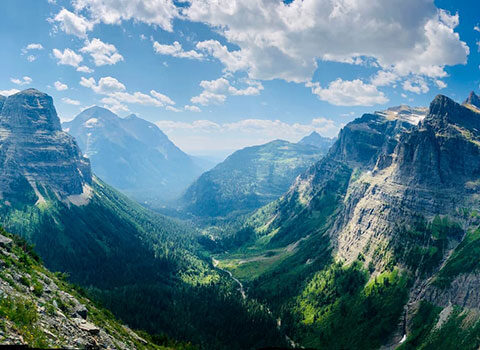Mountain goats are iconic when thinking of Glacier National Park. So let’s learn about them.
Everything You Always Wanted to Know But Were Afraid to Ask

Mountain goats thrive above the treeline. They prefer scaling sheer cliffs and hopping around in boulder fields to the safety of lower meadows and forests. They are sturdy enough to withstand harsh Rocky Mountain winters, but graceful enough to outmaneuver fierce predators with jaw-dropping athleticism. For these reasons, these alpine creatures have become a symbol of the rugged landscape they call home, the Crown of the Continent.
So how do they do it? How do they perform the death-defying stunts for which they are so well-known?
First of all …
Spiderman Hooves
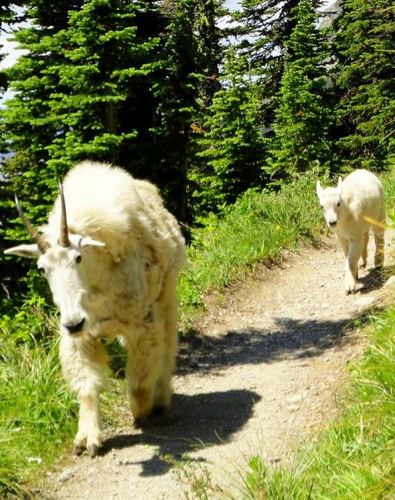
Mountain goats’ hooves are completely unique in the animal kingdom. Most hoofed creatures, or ungulates, as they are called in the science world, have rigid hooves that are made up mostly of a hard outer covering. Only the very bottom is soft and pliable.
Mountain goats, however, have hooves that consist mostly of the soft stuff, with a grippy, sandpaper-like outer layer. This gives mountain goats an enhanced ability to flex their feet and grip with their “toes,” much like a climber wearing a climbing shoe.
Thanks to these sticky, grippy, flexible hooves, mountain goats have a Spiderman-like ability to scamper up practically vertical rock faces. They can gain purchase on the most minuscule ledges.
Because of this, they can feed on lichens, grasses and vegetation that no other animals can reach.
Rock climbing expertise also allows mountain goats to make their home in high, difficult alpine terrain, which keeps them safer. Would-be predators, like mountain lions and grizzly bears, just can’t get to them when they are prancing around on near vertical cliffs.
Masters of the High Jump

It’s not just climbing ability that keeps mountain goats out of reach of predators. Adult mountain goats can jump 12 feet, vertically and horizontally, from a complete stand still.
This incredible jumping ability is something young goats — called kids — start to master within hours of being born. They also practice their climbing moves right away. Being able to scamper around on narrow ledges and steep cliffs gives these amazing animals the ability to go places where large predators can’t follow, which increases their chances of survival.
Young mountain goats develop their skills by playing with other kids their age. They run, chase each other, jump, and scramble around on rocks. Meanwhile, their protective mothers look on and keep an eye out for danger.
Pro tip: Watch out for that goat!
Mountain goats are typically sodium deficient, and are willing to do almost anything to get the salt they crave. They have even been known to aggressively pursue hikers to get to their sweaty, salty gear and clothing. When hiking and camping in mountain goat country, avoid hanging sweaty clothes and gear out to dry unless you can keep a close watch on it. I’ve seen many people unsuccessfully chase after a goat that was running away with their lucky shirt. I’ve had goats try to chew on my backpack — while I was wearing it. This behavior may make mountain goats seem tame, but they are wild, unpredictable animals. Interactions that close are unsafe and should not be encouraged.
Mountain Goats Aren’t Goats
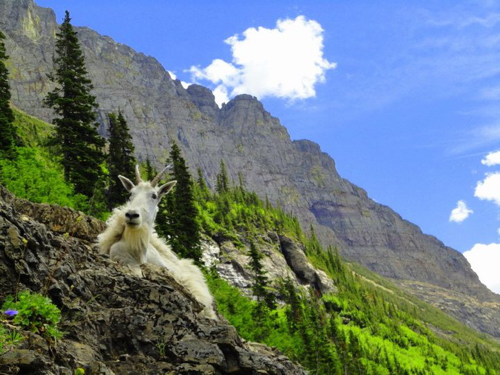
Mountain Goats aren’t actually goats at all. They are more closely related to gazelles and African antelope. They look like goats, smell like goats, and act like goats though, so the mixup is quite understandable.
Lewis & Clark, the early European-American explorers, came across these creatures when they got to the Rocky Mountains. As part of their expedition, they cataloged and attempted to identify plants and animals as they moved westward.
When they came across something new, it often ended up being named for whatever previously known animal or plant it most closely resembled. Because of this, many species of flora and fauna, goats included, ended up with less than accurate names.
In their defense, Lewis and Clark had an awful lot on their plates as they were making their way across a previously uncharted part of the world. Surviving the elements and trying not to starve seem like a worthwhile focus, so a relatively harmless mistake like this one seem forgivable in my book.
Danger in the Sky
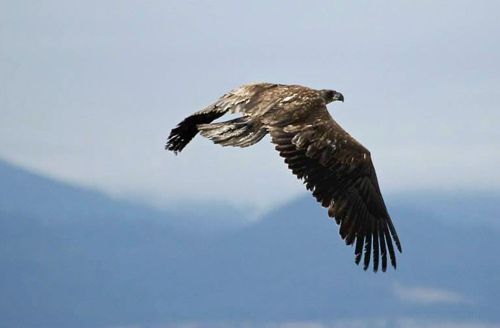
Even though their climbing and jumping abilities give them a distinct advantage, mountain goats aren’t exempt from fear of predators. The biggest threat they face though, comes from an unexpected place: the sky.
Golden Eagles are the largest birds of prey in North America.
Their wingspan is 6 to 7 1/2 feet, and they dive at speeds of more than 150 mph when pursuing their prey. Their swift attack and powerful, sharp talons give them the ability to snatch unsuspecting alpine animals, off the ground.
Because of their unbelievable strength and speed, golden eagles are the number one threat young goats face. To help protect their kids from golden eagles and other predators, the females hang out in groups, with an older nanny goat or two watching over them. Once a nanny group finds a safe place to graze, they fiercely defend that territory and won’t even allow male goats to stay in the area.
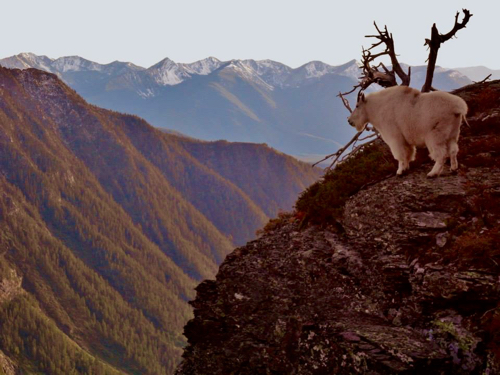
Mountain goats are a symbol of the rugged west, and it’s always a treat to see them in their natural habitat. If you’ve never seen one, let’s go for a hike. I’m always for an adventure above the tree line.
Also, you can read our thoughts here on moose, grizzlies and wolverines, if you’re into that sort of thing. We are.

